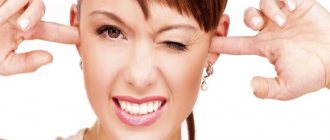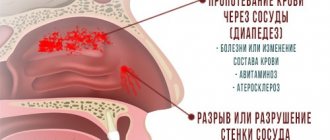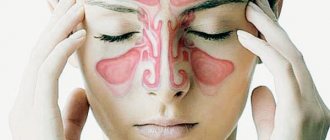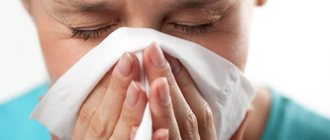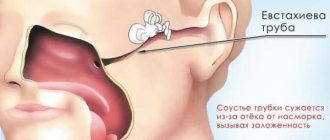Reasons why your head hurts after rinsing your nose
Sometimes there are cases when you get a headache after rinsing your nose. Many people brush off this phenomenon, without thinking about the causes of cephalalgia, taking analgesics. However, they thereby aggravate the overall health situation.
The fact is that a constant headache is a signal that indicates an incorrect procedure technique or the presence of bacterial diseases in the human body.
Therefore, in order not to worsen the situation in this situation, you must immediately contact a specialist.
Why does a headache appear after the nasal rinsing procedure?
Headache after rinsing the nose is quite rare.
In some cases, such a manifestation is the norm, for example, if the manipulation is performed for the first time. But we should not forget that cephalalgia (headache) after a cleansing procedure may indicate such a serious pathology as inflammation of the frontal sinuses. It is possible to provoke a headache after rinsing the nose due to the use of an incorrectly prepared solution.
One should not ignore the fact that violation of the nasal rinsing technique can also lead to the occurrence of this symptom. Our article will be devoted to the causes of headaches when rinsing the nose.
It is important to understand the reason
If you have a headache after rinsing your nose, there is no need to immediately sound the alarm. In some cases, this does not indicate pathologies.
Under normal circumstances, cephalalgia should completely subside within 30 minutes from the end of the procedure. If this does not happen, it is necessary to stop performing nasal irrigations and report such manifestations to your doctor. An otolaryngologist, after collecting a medical history and examination, will find the cause and tell you what to do in this case.
Headache after rinsing the nasal cavity manifests itself:
- with frontal sinusitis;
- if the solution for irrigation of the nasal cavity was prepared incorrectly;
- when washing using the “Cuckoo” method;
- violation of washing technique.
Frontit
Patients should remember that a headache that persists for 24 hours after washing may be a symptom of frontal sinusitis.
In this case, it is localized in the forehead on both sides above the eyes and appears periodically. The pain can have a different character: from unobtrusive discomfort to sharp, pulsating spasms.
Its formation is often associated with excessive irritation of the mucous membranes due to inflammation.
The procedure for irrigating the nasal cavity is not prohibited in case of frontal sinusitis. Otolaryngologists recommend that their patients carry out manipulation, but you need to remember that you can only use a solution approved by the doctor.
It is interesting to note that many otolaryngologists assure their patients that nasal rinsing will help eliminate annoying headaches due to sinusitis.
This happens because flushing allows you to relieve congestion, which is the source of cephalalgia.
This is indeed true, and based on this we can conclude that headaches after rinsing the nose are rare.
Headache after "Cuckoo"
If you have a headache when you first rinse your nose using the Proetz method, this condition is normal. This is due to the peculiarities of this procedure. The technique involves creating negative pressure in the nasal cavity.
This is necessary so that medications can better penetrate the nasal sinuses and thoroughly clean them. During the first procedure, you may not only get a headache, you may even experience nosebleeds.
These complications are peculiar side effects of Proetz lavage.
Of course, such negative phenomena must be reported to the doctor. Perhaps he will select another method that will be gentle on the patient’s body.
Rinsing the nasal cavity, regardless of the chosen technique, is a necessary procedure to ensure rapid relief from pathologies of the nasal cavity. In some cases, it provokes adverse reactions, and this can be attributed to the disadvantages of the methods.
The constant appearance of headaches after manipulation at home is a good reason to visit a specialist.
This is due to the fact that cephalgia after irrigation of the nasal cavity does not always occur due to changes in pressure in the cavities; in some cases, this phenomenon is closely related to the course of other diseases.
Incorrectly prepared solution
To irrigate the nasal cavity, it is best to use ready-made solutions sold in pharmacies, but the high price of such products forces patients to prepare the mixture themselves. During the preparation process, you need to take into account all the subtleties: from using high-quality water to correctly calculating the concentration. The washing solution should be diluted in a clean container.
It is important to remember that the washing procedure can provoke cephalalgia:
- When using contaminated water. In this case, the headache will become just an unpleasant sensation against the background of the risk of infection in the nasal cavity, which can easily penetrate the mucous membranes.
- Do not use hot or cold mixtures to irrigate the nose. Its temperature should be comfortable.
- To prepare a saline solution, it is better to use sea salt. It is important to choose it correctly; any aromatic additives in this case are unnecessary.
Violation of washing technique
It is important to do nasal rinsing at home correctly. There are several ways to carry out the manipulation. The rules are quite simple, but they cannot be broken:
- You should irrigate each nostril in turn.
- There is no need to carry out the procedure before going outside.
- It is important to use a solution at the optimal temperature.
- It is necessary to control the pressure of the solution entering the cavity. There should not be too much of it, as this will not increase the therapeutic effect.
- The procedure should not be carried out too often. This can cause the own microflora of the nasal cavity to be washed out.
Headache after rinsing the nose is quite rare. In most cases, it can be caused by using an incorrectly prepared solution.
Patients should remember to discuss treatment details, such as the concentration of the nasal rinse solution, with their doctor. It is not worth carrying out the procedure too often for hygienic purposes.
Against the background of excessive pressure in the nasal cavities, cephalgia may appear.
Source: https://gaimorit-sl.ru/promyvanie/bolit-golova-posle-promyvaniya-nosa.html
Why does a painful condition occur?
There are several reasons why a headache develops during a cold:
• during high body temperature, vasodilation occurs and increased production of intracranial fluid (CSF), this leads to a headache;
• poisoning of the body by waste products of pathogenic microorganisms;
• complications in the form of inflammation of the paranasal or frontal sinuses.
The condition of a headache due to a cold is often combined with fever, chills, severe runny nose, and cough. The eyes, the area around the forehead, temples, and eyebrows can hurt.
If the pain is severe, vomiting appears, and the body temperature reaches 40 degrees, you need to call an ambulance. Symptoms may signal more dangerous diseases than acute respiratory viral infections or influenza. Meningitis or encephalitis should be excluded.
If the sinuses of the forehead and nose are inflamed, then other signs appear:
• not only the nasal cavity, but also the entire pharynx becomes inflamed;
• headache worsens after a long stay in the cold;
• most often the frontal part and eyes hurt;
• symptoms worsen in the morning due to mucus accumulated during the night;
• increased discomfort when coughing, sneezing, changing temperature, body position.
Most of the oxygen in our body enters through the nose. When you have a runny nose, its supply is disrupted, the brain experiences starvation and pain occurs. This is why it is so important to treat colds that cause nasal congestion.
Causes
The determining factor for finding out the causes of a stuffy nose and migraines is an increase in temperature. In its absence, such symptoms may arise as a result of the following pathologies:
- Chronic rhinitis. With a prolonged runny nose, the nasal mucosa swells, which causes migraines. This may be a consequence of respiratory diseases or excessive use of vasoconstrictors.
- Allergic rhinitis. It occurs against the background of allergies and is accompanied by a lack of oxygen, sneezing, coughing and migraines. Antihistamines will help, as will a visit to the doctor. A similar reaction can occur to almost anything (dust, wool, pollen, food, medicines, cosmetics, etc.).
- Chronic sinusitis . Inflammatory processes in this disease occur in the paranasal sinuses. Characterized by weakness, impaired sense of smell, nasal discharge, nasopharyngeal congestion, dizziness and spasms. In rare cases, fever appears. Self-medication is strictly forbidden, since the disease often develops in parallel with some other infectious pathology.
- Polyps . These are formations in the nasopharynx caused by the proliferation of its mucous membrane. As they enlarge, a person experiences difficulty breathing and a severe headache in the bridge of the nose. Surgery is required.
- Furunculosis . A boil may form on the mucous membrane, which blocks the path of oxygen and, thereby, causes a migraine. Often this creates the impression that there is a shooting in the nose. Treatment should only be prescribed by a doctor.
If, in addition to the main symptoms, there is a rise in body temperature, then this can happen for the following reasons:
- Sinusitis. Inflammation of the sinuses occurs due to infectious diseases, dental problems, and the activity of bacteria and viruses. Initially, discomfort appears in the area of the affected sinus, gradually it intensifies and rises higher, and can put pressure on the cheekbones, temples or ears. There is clear or light green discharge from the nose. Symptoms worsen when tilting the head. With prolonged inflammation, unpleasant sensations appear in the eye area, and conjunctivitis may begin. If the disease has not been treated or is simply ignored, it can lead to meningitis, osteomyelitis or bronchitis.
- Frontit. The inflammatory process in the frontal sinuses leads to hyperthermia, migraines, nasal congestion, pain begins to put pressure on the forehead and eye sockets. Untreated frontal sinusitis can provoke bone necrosis, fistula, brain abscess or sepsis.
- Sphenoiditis. The sphenoid sinus becomes inflamed, which causes pain in the occipital region, malaise, tears, congestion of the nasopharynx and fever. Complications such as meningitis or destruction of the optic nerve are possible.
- Ethmoiditis. This is an inflammatory process of the ethmoid bone mucosa. Appears in bacterial and viral pathologies. At first, a person feels unwell and pain at the base of the nose and in the eye sockets. Then the symptoms are joined by nasopharyngeal congestion and copious mucus discharge. Complications: meningitis, abscess and blurred vision.
- Sometimes, when the nose is blocked, migraines and hyperthermia begin, and pain in the larynx may appear. This happens with the flu or a cold. Without proper treatment, even a respiratory disease can lead to pneumonia, meningitis and heart problems. The first rule for eliminating a cold is good sleep.
- If something clicks in the nose during a migraine, it could be the consequences of an injury, infectious or bacterial inflammation that appears as a result of advanced forms of pathologies.
- , nasopharyngeal cancer causes clogged nostrils and headaches That is why it is so important to consult a doctor at the first unpleasant sensations. Then it may be possible to recognize the tumor at an early stage.
- Sinus congestion and migraines during pregnancy occur as a result of toxicosis and hormonal changes in the body . There is no way to cure them; you just need to endure this period.
- Dry indoor air also causes nasal congestion and migraines, especially in the morning. To avoid this problem, it is recommended to ventilate the room and humidify the air before night.
Why rinse your nose with salt water?
Rinsing your nose with saline solutions can be used both for treatment and for the prevention of various ailments. During the cold season, this way you can reduce the likelihood of developing infectious diseases. This procedure is often performed by people who are forced to stay in very dusty rooms for a long time. Nasal rinsing is indicated for diseases of the respiratory system such as sinusitis, rhinitis, sinusitis, ARVI and influenza.
Do you know how to treat sinusitis at home? All about home treatment for sinusitis.
Are you suffering from a persistent cough? Read about the symptoms of chronic pharyngitis at this link.
How do different nasal remedies work?
Nasal drops are the most common self-help remedy among the Russian population. Their main advantage is that they quickly relieve the condition and are relatively inexpensive. The disadvantage is that they act only on a small area of the mucosa, without removing pathogenic viruses and microbes. They are addictive with prolonged use and contain synthetic drugs.
Sprays and aerosols are essentially the same drops with a different bubble shape. Advantages: the nebulizer allows you to cover a slightly larger area of the mucous membrane, and they often contain moisturizing substances. However, they also do not flush out mucus and germs from the sinuses. This is their main drawback.
To summarize, we have to admit that the best way to make breathing easier is to combine rinsing with nasal drops or spray.
- you try to rinse your nose when it is stuffy;
- you already have a perforated eardrum;
- You are pressing too hard on the bottle.
Accordingly, you can avoid otitis media in the following ways:
Many people know that the nasal cavity is connected to the middle ear through the Eustachian tube. In an adult, the length of the Eustachian tube is up to 3.5 cm. In childhood, it is, of course, smaller, its length is from 1.5-2 cm. If you do nasal rinsing incorrectly. As a result, water or another medical solution in the form of a solution may penetrate into the middle ear.
- if a person begins to rinse at a time when his nose is very stuffy;
- if the patient has perforation of the eardrum itself. But it is worth noting that such a disease (otitis media) can only occur if there is already an infection in the ear cavity. Therefore, as soon as you get a blocked ear after rinsing the nasal cavity, you should immediately visit a doctor. Especially if there is a tendency to develop otitis media.
Also note that if you already have otitis media, then you should not rinse your nose.After which, you will need an empty, clean, compressed bottle and apply it to your nostril. Please note that we close the second sinus with our finger, and in the sinus where the bottle is located, it must be unclenched. This simple manipulation allows you to quickly remove the fluid that remains directly in the sinus. You can also use a small baby bulb or, for example, a special aspirator.
First of all, you need to see a doctor who can prescribe you the appropriate treatment. Most often, doctors first prescribe ear drops, for example:
- "Normax";
- For otitis media, antibacterial drops may also be prescribed, such as Ciprofloxacin or anesthetic drops, most often prescribed Xylocaine.
- In case of severe inflammation, in addition to medications, the doctor prescribes physiotherapeutic procedures. For example: phototherapy, ultraviolet, in rare cases, a “quartz tube” is used.
Useful video about nasal rinsing
Treatment of a runny nose can be carried out using a variety of techniques. And some of them need to be used especially carefully so as not to harm yourself. Thus, various inhalations, heating and other thermal procedures are strictly contraindicated at elevated body temperatures and when the development of purulent processes is suspected. And popular washings can only be carried out skillfully, so that the liquid for this procedure does not get into where it is not needed. But if, when washing your nose, water gets into your ear, then let’s clarify what to do.
The hearing aid has a rather complex structure, and in addition, it is closely connected to the nasal cavity via the Eustachian tube. In adults, the length of this section is approximately three and a half centimeters, and in children it is one and a half to two centimeters. In some cases, improper medical procedures, such as nasal rinsing, can lead to fluids entering the middle ear.
Most often, water can get into the ear during rinsing in children, due to the structural features. In both children and adults, it can be triggered by too sharp pressure on the bottle of solution, which leads to the injection of liquid under particularly high pressure. Liquid getting into the ear is possible if rinsing is carried out at a time when there is severe nasal congestion. And when rinsing, water ends up in the wrong place if a person has a perforated eardrum.
How does water get into the ear when rinsing the nose?
?
Typically, such a situation makes itself felt by a feeling of nasal congestion and a feeling of discomfort. Many patients with this problem complain of feeling slightly dizzy.
In some cases, this situation leads to disruption of protective mechanisms and provokes the development of inflammation - otitis media. Doctors say that such a disease can develop if there are already certain aggressive particles (infectious agents) in the ear cavity. That is why, if you feel water getting into your ear after rinsing your nose, it would be a good idea to consult a doctor. This advice is especially important for those who are prone to frequent otitis media.
What to do if water gets into your ear while rinsing?
?
If you feel discomfort in your ear while rinsing your nose or immediately after it, try quickly using nasal drips using vasoconstrictor drops or spray. In this case, the head should remain tilted towards the problematic ear for three to five minutes. Five minutes after this, take an empty, clean medicine bottle, squeeze it and insert the tip into the nasal passage. Close the second sinus of the nose with your finger. Squeeze the bottle directly into your nose, which will help eliminate fluid remaining in your sinuses. Repeat with both nasal passages. To carry out such a simple procedure, you can use a small baby bulb and a special aspirator.
If water gets into the ear canal not due to severe swelling of the nasal mucosa, try making several frequent swallowing movements in a row. You can also chew gum. This will promote natural fluid drainage.
If the discomfort has passed and does not bother you anymore, then stop rinsing your nose for four to five days and be sure to consult a doctor.
If, after rinsing your nose, water gets into your ear and pain occurs
? If you are unable to see a doctor immediately and there is pain in your ear, use special ear drops, such as Otinum or Otipax. But keep in mind that such remedies should never be used if there is a suspicion of perforation of the eardrum, which is accompanied by severe pain and, often, discharge of blood or fluid with pus.
Place the medicine in the problematic ear and wait about ten minutes. Then take the turunda, moisten it in warm boric alcohol and insert it into the ear canal. A warm compress should be placed on the problematic ear overnight. It is worth remembering that this procedure is contraindicated if the pain occurs against a background of high temperature. To relieve pain, you can take a painkiller, such as ibuprofen. To completely eliminate the problem, you must consult with an otolaryngologist (ENT).
How to prevent water from getting into your ear when rinsing your nose
?
To avoid liquid getting into the ear when rinsing the nose, you should adhere to the basic technique of carrying out such a procedure. The bottle of medicine must be squeezed slowly in order to be able to smoothly regulate the pressure of supplying the medicine to the nasal cavity. In this case, you need to tilt your body and head forward ninety degrees. In this position, the liquid simply will not be able to penetrate into the middle ear.
If you are concerned about severe nasal congestion, then before the rinsing procedure (about three to five minutes before it), perform nasal instillation using vasoconstrictors. Such medications will effectively eliminate swelling of the mucous membranes or reduce it, preventing the solution from refluxing into the auditory tube.
You should not rinse the nose of young patients whose age has not yet reached five years, without consulting a doctor. After all, as we already mentioned just above, in children the auditory (Eustachian) tube is shorter and wider, and liquid can easily get into it when washing the nasal passages.
Penetration of liquid into the ears during nasal hygiene procedures causes discomfort, pain, blockage of the air cavities, and a number of other unpleasant symptoms. Compliance with the algorithm and recommendations for performing therapeutic and preventive procedures for cleansing the accessory sinuses will help avoid side effects.
What should you do if your ear hurts after rinsing your nose? Normally, the situation tends to resolve itself; the water should flow out on its own. If this does not happen, the problem is eliminated with the help of complex actions and pharmaceuticals.
Therapeutic manipulations are prescribed when the upper respiratory tract is damaged by pathogenic agents and antigens, in order to prevent respiratory diseases.
Mechanical cleansing
of the paranasal sinuses is aimed
at removing residual mucus, dust, pathogenic strains and their metabolic products.
Irrigation of the canals helps to systematically moisturize the epithelium, prevent the formation of crusts, restore the functioning of the mucociliary apparatus, drainage of the sinuses, and relieve the symptoms of pathological changes.
To cleanse the air cavities, saline solution is most often used. The first option is prepared at home, using a tablespoon of salt per 1 glass of water.
. Using a syringe, a medical bulb or an aspirator, the liquid is injected into each nasal opening one by one.
Among pharmaceutical products, the mineral-herbal complex “” has become widespread. The consistency of the medicinal liquid is identical to the physiological characteristics of the liquid environment inside the body.
The composition of the drug combines eukaryotic cells and chemical elements, which provides an antiseptic and anti-inflammatory effect
. The drug exhibits immunomodulatory activity, accelerates the process of soft tissue regeneration, relieves swelling and inflammation of the inner membrane.
When there is a concentration of water in the middle ear, the patient experiences an acute sensation of pain, a partial decrease in the ability to perceive sound
For reference!
"Dolphin" is produced in a children's dosage of 120 ml. and adult, volume 240 ml.
When administered correctly, the solution washes the nasopharynx and flows out through the free nostril. During the procedure, water may enter the ear.
. This fact is explained by the features of the anatomical structure.
The hearing aid communicates with the nasal cavity through the Eustachian tube. The main purpose of the channel is to regulate internal pressure and remove fluid. With a strong pressure of the medicinal liquid, the canal opens, part of the water flows into the projection of the middle ear.
Situations where the ear becomes blocked after washing the nose arise for the following reasons:
:
- blockage of the accessory canals, nasal congestion;
- excessive solution supply pressure;
- incorrect body position, head tilt angle.
The procedure requires special care when there is a violation of the anatomical structure of the osteochondral structure of the facial skeleton
. Deformation of the nasal septum and ear is a common cause when water gets into the ear when washing the nose.
Incorrectly prepared solution
It is necessary to rinse your nose only with the solution prescribed by the doctor. If you prepare it yourself, there is a risk of mistakes. First, you need to use purified water. Secondly, its temperature should not be cold or hot.
And thirdly, the salt concentration in the solution should be equal to isotonic (0.9%). Otherwise, you can provoke irritation of the mucous membrane, increased secretion, and even the addition of a secondary infection.
It is then that swelling increases, and due to impaired drainage of the sinuses in the corresponding projections, a feeling of pressure arises.
Olive for rinsing the nasal cavity
Oliva for rinsing the nose is a device for rinsing the nose, which consists of a tip and a fitting for a hose filled with a solution.
The device is used not only for a runny nose, but also for the prevention of rhinitis and sinusitis. It can be used for treatment at home, and the price of the device is quite affordable.
The device is available in different diameters, depending on who it is intended for - an adult or a child.
Physiotherapy
In the chronic form of diseases, along with conservative methods, the following are used:
- Electrophoresis. Using small current discharges, medicine is delivered to the mucous membrane, but the gastrointestinal tract is not affected.
- Inhalations. This is the best home therapy method. The procedures are carried out with essential oils (eucalyptus, peppermint).
- UHF. A drug with electromagnetic fields penetrates the human body and modifies the structure of cells.
- Paraffin applications. Heated paraffin has an anti-inflammatory effect, improves blood circulation, triggers metabolic processes in tissues and promotes cell restoration.
Before each procedure, you should consult a doctor.
Complications
If you do not remove water from the hearing organ in a timely manner, this can lead to unpleasant consequences. The presence of water in the auditory organ leads to a change in the normal level of the body, and also creates favorable conditions for the proliferation of bacteria, viruses and fungi. If water gets into it, the possibility of the following ailments cannot be ruled out:
All inflammatory processes that occur in the auditory analyzer can subsequently affect the inner ear, which threatens hearing loss and complete hearing loss.
How to help if you washed your nose and your ear hurts
It is possible to prevent the concentration of moisture in the cavity of the hearing organ during cleansing of the nasal canals if you follow the procedure technique
.
Manipulations are carried out in a standing position (or sitting over a sink/bowl), with a horizontal head tilt of 90°
, gaze purposefully directed at the floor. Squeeze the bottle with the solution evenly to regulate the strength and volume of water supply.
Dosage 250 ml. provided for one procedure in 4 entries.
Fluid in the middle ear cavity provokes pain, creates the sensation of boiling water, and the presence of external noise. Ignoring signs of pathology is fraught with the development of complications - eustachitis, myringitis, epitympanitis.
Children are allowed to rinse their nose from the age of three under adult supervision.
Nuance!
Thermal effects of a hairdryer are contraindicated. Attempts can dry out the epithelium of the ear canal and cause increased air flow, which only activates the inflammatory process.
Due to the presence of white matter crystals in the saline or saline solution, concentration of fluid in the ear should not be allowed
. Prolonged irritation of the inner shell is manifested by an inflammatory process, creating favorable conditions for the development of pathogenic microflora.
How to get rid of water in the ear
It is impossible to remove water from the ear canal with cloth pads. An integrated approach is needed here:
- Induce natural fluid removal
. To completely empty the ear projection of water, you need to tilt your head forward and jump up and down. Dip the cavity with a cotton pad and carefully continue hygiene or nasal therapy. - Simulate swallowing movements
.
Take a deep breath, hold your breath for 2-3 minutes
, repeat the manipulations. Actions help to recreate the reverse cycle, the water returns to the auditory tube and flows out through the accessory nasal canals. Chewing gum provides an identical result. - Remove moisture with an aspirator
. Carefully and shallowly insert the tip of the electromechanical device into the nasal passage from the problematic side of the ear, closing the second nostril with the index finger. You can use a medicinal bulb or an empty medicine bottle. - Place vasoconstrictor drugs into the nose
. Nasal drops restore cavity drainage, relieve inflammation, relieve swelling, which helps improve the patency of the middle ear canal. - Administer antihistamines
. They actively fight swelling of the auditory tube, which arose as a result of exposure to antigens. After restoring the functions of the Eustachian junction, repeat the recommendations of paragraphs 1-2. - Seek medical help
.
If your ear hurts, ear drops “Otinum”, “” will be effective. The drugs exhibit anti-inflammatory, antiseptic, and local anesthetic effects. 2-3 drops are instilled into the external auditory canal every 4 hours.
It is not recommended to use pharmaceutical products in case of hypersensitivity to individual components or in cases of violation of the integrity of the eardrum. Ibuprofen-based analgesics - Nurofen, Ibuklin, Ibufen, Next, Mig-200 - will help relieve pain.
For reference!
To remove moisture from the outer part of the auditory organ, press the palm tightly against the protruding part of the ear until the inner side of the hand grabs the auricle, sharply withdraw it, and so on for several
Rinsing the nose with saline solution: simple and effective tips
Nasal rinsing is a procedure widely used in both folk and official medicine. It has become widespread in India, where it is considered the same mandatory morning procedure as washing and brushing your teeth. Thanks to this, residents in this country are less likely to suffer from infectious diseases.
In our country, there is a widespread belief that rinsing the nose is necessary only when treating runny nose and colds. Few people know that this is an excellent remedy for preventing infections.
How many times a day is it acceptable to rinse your nose?
Many people are interested in the question of how many times a day they can perform the nasal rinsing procedure at home. It is best to rinse every day, for preventive purposes, using boiled water or decoctions of medicinal herbs.
If the procedures are carried out to treat inflammatory diseases of the nose and nasopharynx, as well as a runny nose, then the procedure can be performed quite often - 3-4 times a day. The course of treatment is approximately 5-7 days.
If there are no visible results, it can be continued after completion.


